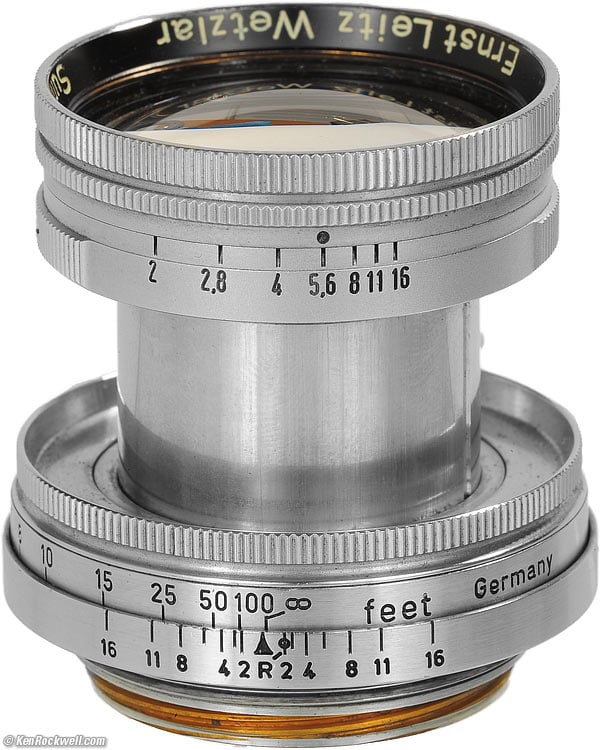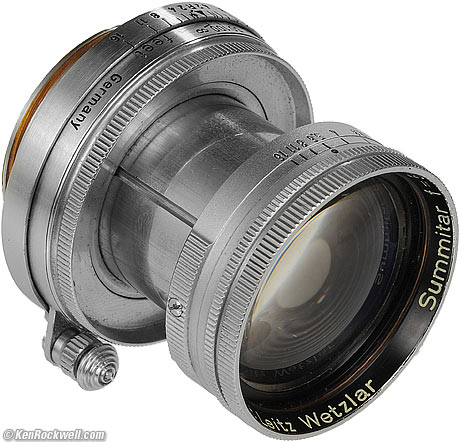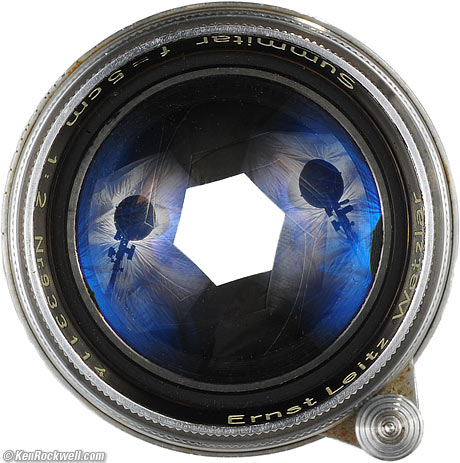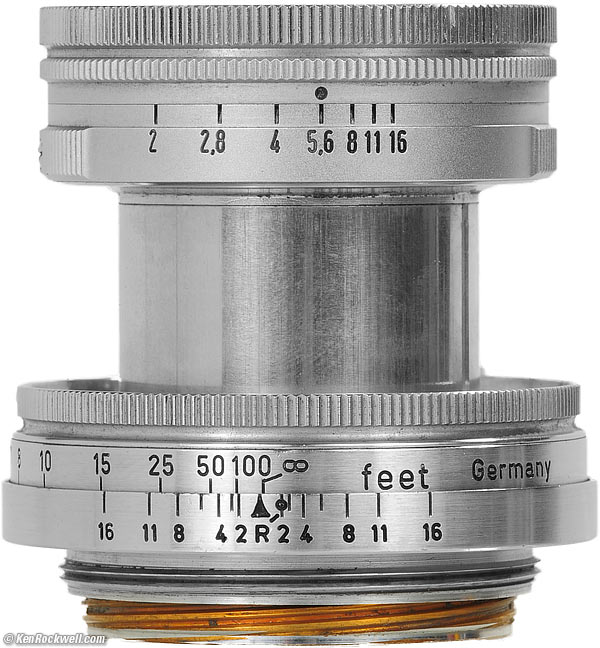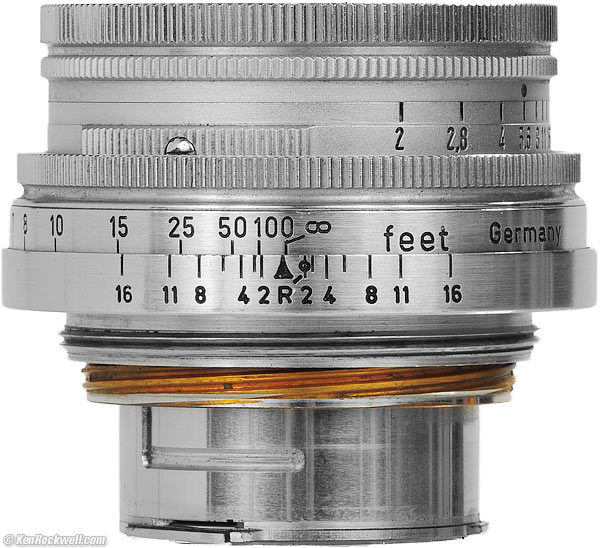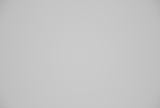Home Donate New Search Gallery Reviews How-To Books Links Workshops About Contact
LEICA 50mm f/2
SUMMITAR
(1939-1953)
© 2011 KenRockwell.com. This page best with Corporate S regular and bold activated.
Intro Specs Performance Recommendations
LEICA SUMMITAR 50mm f/2 (special type L filters, 7.3 oz./206g, about $300). Vergrößern. This this free website's biggest source of support is when you use these links, especially this direct link to this lens at eBay (see How to Win at eBay), or at Adorama, when you get anything, regardless of the country in which you live. Thanks! Ken.
February 2011 LEICA Reviews LEICA Lenses lesser-brand reviews
See also the newer LEICA SUMMICRON 50mm.
Introduction top
Intro Specs Performance Recommendations
|
Adorama pays top dollar for your used gear. I use these stores. I can't vouch for ads below. |
The LEICA SUMMITAR 50mm f/2 is an extremely sharp lens in the center, and softer on the sides compared to LEICA's newest lenses. In most cases, no one will notice any difference.
This LEICA SUMMITAR 50mm f/2 was Leica's highest-performance normal lens from 1939 until it was replaced by the SUMMICRON in 1953.
This SUMMITAR replaced the earlier SUMMAR 50mm f/2, which was the hot, must-have LEICA lens from 1933-1939. This SUMMITAR was in turn repalced by the improved SUMMICRON in 1952.
This SUMMITAR uses much larger front optical components than the SUMMAR for greatly reduced mechanical vignetting for less light falloff. LEICA pitched this as especially important for the new color work for which this SUMMITAR was particularly well suited.
Additionally, the new front optical component of this SUMMITAR is now two cemented elements, replacing the single front element of the older SUMMAR.
Compatibility top
This LEICA SUMMITAR 50mm f/2 works perfectly on every LEICA M camera, from the LEICA M3 of 1954, today's LEICA M7, LEICA MP and LEICA M9, so long as you use a simple screw-mount adapter.
Without the adapter, this SUMMITAR works flawlessly on all traditional (screw-mount) LEICAs, like the popular LEICA IIIf.
These screw-mount lenses are thus perfectly compatible with all LEICAs made since 1932.
Be careful with the lesser LEICAs, like the LEICA M9, whose user manuals caution that design flaws in these newer cameras may not be compatible with collapsing this lens as designed. LEICA goes so far as to warn that these defects will lead to the destruction of the M9 if you collapse a lens into it as intended by The Prophet.
I measure 18.18mm extension from the rear flange when fully retracted. I collapsed this on an M9 with no problem, which seems to have a few millimeters left over for safety.
Versions top
This same optical design came in a few versions.
The SUMMITAR was uncoated prior to World War II, and was coated from about 1946 (about serial nr. 601,001).
The SUMMITAR originally had a 10-bladed diaphragm, which was changed back to the complex 6-bladed design of the previous SUMMAR (1933-1939) in 1950.
LEICA SUMMITAR 50mm f/2. Vergrößern.
Specifications top
Intro Specs Performance Recommendations
Name
Leica calls this the LEICA SUMMITAR 5cm f/2.
Optics top
7 elements in 4 groups.
Herein lies the secret of the SUMMITAR's performance: most other 50mm f/2 lenses, like Nikon's 5cm f/2 for their contemporary rangefinder cameras, have never used more than 6 elements.
Uncoated before WWII, then single-coated in blue from 1946.
Diaphragm top
LEICA SUMMITAR 50mm f/2, at f/5.6. Vergrößern.
The diaphragm used 10 blades in 1939, and oddly went back to 6 blades in 1950.
The 6-bladed diaphragm is a mechanic's nightmare, deliberately designed to mushroom forward inside the lens.
There are no click stops; these weren't introduced until 1953's SUMMICRON.
It stops down to f/16.
Close Focus
1 meter or 3.3 feet (one scale only).
Filters
Orange SUMMITAR filter. enlarge.
The SUMMITAR takes special conical L type filters which screw into its front. The filters thread into the inside threads of the front-group retaining and identity ring, not the outside of this ring as with most lenses.
Most people today use the LEICA SNHOO adapter to attach ordinary 39mm filters to the SUMMITAR.
If you have these SUMMITAR (type L) filters, you can use an SOOTF (13 079) adapter to use them on older A36 (type H) lenses.
Size top
Slip-over front-mount diameter: 41.47mm (1.636").
This is a half-millimeter (19.7 mils) smaller than LEICA's traditional A42 front accessory mounts since the 1950s, so traditional caps and hoods will be loose.
Collapsed
42.29mm (1.665") overall.
24.08mm (0.948") forward extension from flange by 47.83mm (1.883") diameter.
18.18mm (0.716") maximum rear extension from flange.
Extended
50.19mm (1.976") overall.
42.65mm (1.679") forward extension from flange by 47.83mm (1.883") diameter.
7.24mm (0.285") rear extension from flange.
Weight top
7.275 oz. (206.2g), measured, 1950 model, no adapter.
Caps top
The correct front slip-over cap is a smaller A41.5, not the common A42 caps used since the 1950s.
Therefore, most slip-on front caps won't stay put. Be sure to get a real SUMMITAR cap.
The rear cap is any standard screw-mount rear cap, or M-cap if you use an adapter.
Hood top
The ridiculous barn-door style SOOPD was standard.
While all the traditional A42-mount hoods, like the 12 585, do clamp-on, they are a bit loose because the SUMMITAR's front-mount diameter is a half-millimeter (0.020") smaller in diameter than newer E39-filtered lenses.
Part Numbers top
SOORE, screw-mount, collapsible-mount only, as The Prophet intended.
Quality top
Made in the Holy City of Wetzlar, Germany: MADE IN GERMANY.
Performance top
Intro Specs Performance Recommendations
Overall Bokeh Diaphragm Distortion Ergonomics
Finder Blockage Focus Falloff Lateral Color Mechanics
Sharpness Spherochromatism Sunstars
Overall performance top
This LEICA SUMMITAR 50/2 is a great lens, optically and mechanically. Its central sharpness is extraordinary.
It's not as sharp on the sides if you count pixels, but if you do, it is highly unlikely that you are a good photographer, in which case you should be shooting a new SUMMICRON-M.
Bokeh performance top
Bokeh, the character of out of focus backgrounds, not simply how far out of focus they are, is fair in the center, and downright weird on the sides.
Here are crops from the center of 100% LEICA M9 images, focused on a reference phase lattice at 3 meters (10 feet) with synthetic reference vegetation at 15 meters (50 feet). Printed full-image at this size, these would be about 52 x 35 " (130 x 90cm) prints, at least as seen on most 100 DPI computer monitors. These examples with a 1950 SUMMITAR with a 6-bladed diaphragm. The earlier 10-bladed version will be the same, except that any slightly hexagonal blobs will be rounder with 10 blades. They will retain the same character.
If you want great bokeh, you want the Zeiss 50mm f/1.5 C Sonnar ZM.
Contrary to old wives' tales, lens designers back in the slide-rule and trig-table days of 1939 of this lens were happy to calculate a lens design that was sharp wide-open or sharp in most of the center of the image, and side sharpness was very difficult. Being able to optimize a design considering also bokeh just didn't happen; good or bad bokeh just happened, which is why the bokeh on the sides of old lenses gets so weird.
Central Bokeh
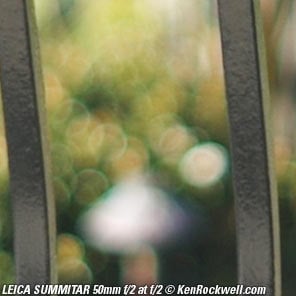 |
 |
 |
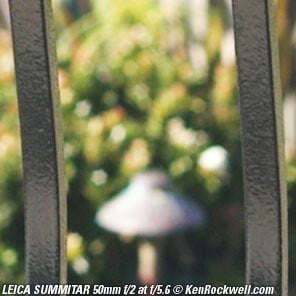 |
Far Left-Side Bokeh
 |
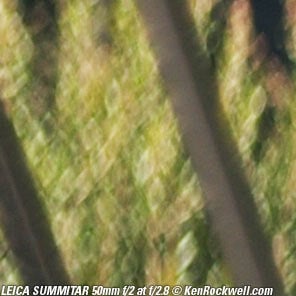 |
 |
 |
The bokeh doesn't change much on the side as stopped down as the mechanical vignetting keeps the effective speed at the sides about the same at the larger apertures.
Diaphragm performance top
There are no click stops. Click stops were a hot new feature added in 1953 with the new LEICA SUMMICRON 50mm f/2.
The diaphragm had 10 blades at first in 1939, but then in 1950 (around serial number 792,001), someone at LEICA discovered a big pile of left-over 6-blade assemblies from the old SUMMAR (1933-1939). LEICA unloaded these over the last few years of the SUMMITAR, as it worked on the extraordinary new SUMMICRON that was to come out in 1953.
Distortion performance top
The LEICA SUMMITAR 50mm f/2 has very minor pincushion distortion.
For more critical use, use a value of -1.10 in Photoshop's lens distortion filter at 3 meters (10 feet).
Ergonomics performance top
LEICA SUMMITAR 50mm f/2. Vergrößern.
Ergonomics are classic LEICA: rotate to unlock and extend or retract, aperture ring up front, and focus in the rear.
There are no aperture click stops. LEICA didn't invent them until 1953 with the SUMMICRON. The smaller stops are too close together for my taste, I find it easy to set fractional stops only up to around f/8.
There is a focus button (not seen here, behind the lens), as well as a narrow knurled focus ring.
The focus locks at infinity so you can grab the focus tab as a steady lever with which to mount and unmount the lens.
LEICA SUMMITAR 50mm f/2, collapsed. Vergrößern.
This lens collapses for compact carrying. It works fine on the M9 I borrowed, but LEICA cautions that design flaws in the M9 might lead to destruction of the M9 if you collapse your lens into your camera. Be careful.
Finder Blockage performance top
There is no blockage on an M camera, without the hood.
On a LEICA IIIf, there is a small bit of the bottom right blocked. If this is annoying (I doubt it), use a shoe-mounted finder.
Focus performance top
Focus accuracy is a personal issue between your sample of body and your sample of lens.
This said, this particular sample was perfect on my 2009 LEICA M9.
Falloff (darker corners) performance top
The LEICA 50mm f/2 SUMMITAR has minor falloff at f/2, and none by f/4.
I've greatly emphasized it below by shooting a gray field and presenting it against another gray field.
LEICA SUMMITAR 50mm f/2 falloff on M9 at infinity,
© 2011 KenRockwell.com. All rights reserved.
|
Lateral Color Fringes performance top
There are no color fringes on a LEICA M9.
Color fringes, if there were any, would be even less visible on film, they are lost in the grain.
This SUMMITAR is a lot better than most zooms today!
Materials and Construction performance top
This SUMMITAR is the standard against which other lenses have been judged for over 60 years.
It's all chromed brass. There is no plastic (screw-mount lenses have no mounting index balls).
All the markings are engraved and filled with paint.
Rear, LEICA SUMMITAR 50mm f/2. Vergrößern.
Sharpness performance top
The more you know about photography, the more you know that lens sharpness doesn't matter.
This SUMMITAR is as sharp in the center as the modern SUMMICRONs at every aperture, and just a teeny-tiny bit less soft in the center at f/2 than today's SUMMICRON-M. This means that even if you're shooting M9 DNGs and looking really close, the center sharpness will scare you.
The sides are less sharp. This is this lens' character. If you want surgically-sharp sides, duh, shoot a new SUMMICRON-M.
This SUMMITAR is sharp enough for most work today, and is a perfect example of why LEICA's lenses have always been held in such high regard. In its day, LEICAs had to compete in sharpness with the more popular 4x5" and 5x7" cameras shot by most people.
Spherochromatism performance top
Spherochromatism is invisible in the LEICA SUMMITAR 50mm f/2, at least in my initial shooting.
Spherochromatism, mistakenly called "color bokeh" by laymen, is when out-of-focus highlights take on colored fringes, usually green and magenta. This lens doesn't do this, unlike many fast normal lenses.
Sunstars performance top
The 10-bladed diaphragm ought to create 10-pointed sunstars on brilliant points of light, while the newer 6-bladed versions will create silly 6-pointed stars. The 6-pointed stars are most useful for Christmas, ski and snow-boarding photography, mimicking snowflakes.
Recommendations top
Intro Specs Performance Recommendations
This SUMMITAR is a perfectly swell and sharp lens for photography today.
If you have one, enjoy it.
I wouldn't recommend you go looking for one of these. As the youngest of these is 60 years old, you are highly unlikely to find one without internal haze, regardless of how well kept it was. As the glass was as soft as chalk, most samples will also show exterior glass wear, euphemized as "cleaning marks" by people trying to sell you bad lenses.
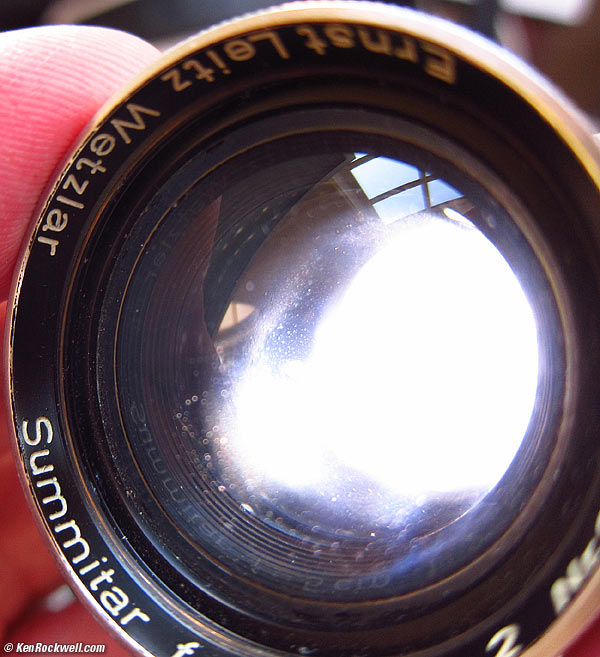
A SUMMITAR failing the flashlight test.
If you purchase a SUMMITAR, be sure it passes the flashlight test. The lens seen here had very little haze visible to the naked eye. It had moderate haze under the flashlight test. A lens like this can give decent images with the light at your back, but shooting against any sort of backlight, or shooting against a window indoors, the haze wildly blows-out the bright backlights and severely lowers the overall contrast.
If you need a fast screw-mount lens, this SUMMITAR is swell, but you'll still have a hard time finding a good one. The SUMMICRON also comes in screw mount, but it has the same haze and soft-as-chalk glass problems as this SUMMITAR.
If you want good bokeh, this SUMMITAR has hideous bokeh. Get the Zeiss 50mm f/1.5 C Sonnar ZM instead, which has extraordinarily good bokeh. (The Zeiss won't work on screw-mount cameras, while the SUMMITAR will.)
If you find these reviews of old gear helpful, this free website's biggest source of support is when you use these links, especially this direct link to this lens at eBay (see How to Win at eBay), or at Adorama, when you get anything, regardless of the country in which you live. You also can get them locally in Southern California at OC Camera. Thanks! Ken.
Acknowledgements top
Many thanks to OC Camera for loaning me this lens to review.
Help me help you top
I support my growing family through this website, as crazy as it might seem.
The biggest help is when you use any of these links to Adorama, Amazon, eBay, B&H, Ritz, Calumet and J&R and when you get your goodies. It costs you nothing, and is this site's, and thus my family's, biggest source of support. eBay is always a gamble, but all the other places always have the best prices and service, which is why I've used them since before this website existed. I recommend them all personally.
If you find this page as helpful as a book you might have had to buy or a workshop you may have had to take, feel free to help me continue helping everyone.
If you've gotten your gear through one of my links or helped otherwise, you're family. It's great people like you who allow me to keep adding to this site full-time. Thanks!
If you haven't helped yet, please do, and consider helping me with a gift of $5.00.
As this page is copyrighted and formally registered, it is unlawful to make copies, especially in the form of printouts for personal use. If you wish to make a printout for personal use, you are granted one-time permission only if you PayPal me $5.00 per printout or part thereof. Thank you!
Thanks for reading!
Mr. & Mrs. Ken Rockwell, Ryan and Katie.
Home Donate New Search Gallery Reviews How-To Books Links Workshops About Contact
